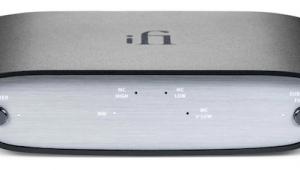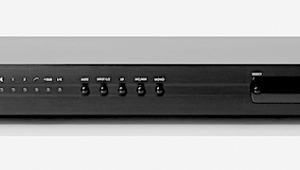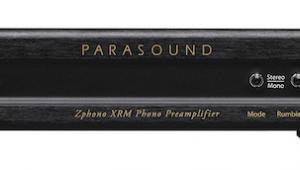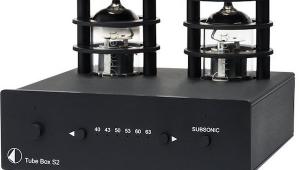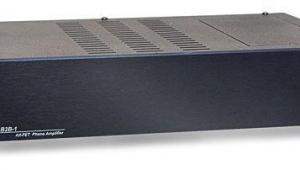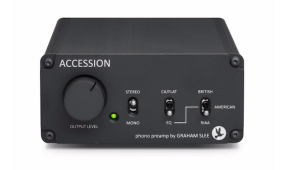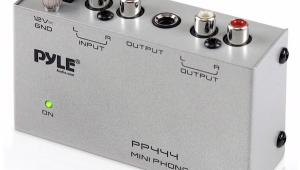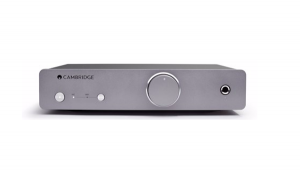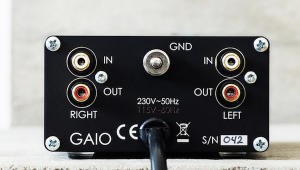Abbingdon Music Research PH-77 Phono Equaliser Measurements
"The PH-77 is a sweet, tonally well-balanced, quiet performer that produced a large, authoritative sonic picture packed with honest detail," summed up Michael Fremer, adding that "its weakest suit was its inability to produce full macrodynamic expression." I am not sure what measurement would indicate that to be the case, but from its flight-case packing to its substantial construction—it weighs 65 lbs—and its informative blue front-panel display, the PH-77 is an impressive piece of gear.
I measured the PH-77 (serial no. 2410003) with Stereophile's loan sample of the Audio Precision SYS2722 system (see the January 2008 "As We See It" and www.ap.com), using the Direct input, with the generator floating but a separate wire connecting its ground to that of the preamplifier, which gave the lowest level of measured noise. The PH-77 offers four levels of gain in moving-magnet mode (30, 36, 42, and 48dB), and four in moving-coil mode (54, 60, 66, and 72dB). With the preamp's input impedance set to 47k ohms, the measured gain at both the balanced and unbalanced outputs matched the specified gain within 0.5dB in MM mode and 0.1dB in MC mode. Both sets of outputs preserved absolute polarity; ie, were non-inverting.
The preamp's input impedance in MC mode can be varied in 32 steps from 47 ohms to 47k ohms. I checked the impedance at 47, 72, 100, 300, 1500, and 47k ohms; the corresponding measured figures at 1kHz were 48, 73.5, 104.5, 289, 1450, and 44k ohms, respectively. The 20Hz impedances were generally the same as at 1kHz, the 20kHz figure a little higher. In MM mode, the input impedance was 46k ohms at low and midrange frequencies, dropping slightly to 38k ohms at 20kHz with the lowest (70pF) of the 32 parallel capacitance settings. The output impedance at midrange to high frequencies was basically to specification, at 400 ohms balanced and 220 ohms single-ended. It rose to around 3k ohms at 20Hz, however, which suggests that the PH-77 should be used with a preamplifier having an input impedance of at least 20k ohms if the low bass is not to sound slightly lean.
The PH-77 offers a large number of equalization curves. Set to "RIAA," the response sloped down slightly from 40Hz to 20kHz and included the IEC-recommended high-pass filter, giving an output down almost 3dB at 10Hz (fig.1, blue and red traces). While the ultrasonic response was –2.2dB at 100kHz with this EQ, switching to "Enhanced RIAA" (fig.1, cyan and magenta traces) resulted in a rising response above the audioband, this the so-called "Neumann fourth pole," which is intended (fallaciously) to compensate for the cutter head's departure from a perfect preemphasis curve.

Fig.1 Abbingdon Music Research PH-77, response with: RIAA correction (left channel blue, right red), Enhanced RIAA (left cyan, right magenta), RIAA (DMM) (left green, right gray). (1dB/vertical div.)
The green and gray traces in fig.1 show the response with "RIAA (DMM)" deemphasis; this introduces a broad, deep depression in the mid-treble. I didn't measure any of the mono equalization settings, but there were three other stereo options, which are shown in fig.2. The "Decca ffss" (blue and red traces) and "Columbia" (cyan and magenta) settings both shelve down the treble, but with different low-frequency rolloffs. The "CCIR 56" setting (green and gray) shelves the treble up by 4dB. The channels match very closely in all cases, but with the left channel 0.2dB higher than the right.

Fig.2 Abbingdon Music Research PH-77, response with: Decca ffss correction (left channel blue, right red), Columbia EQ (left cyan, right magenta), CCIR 56 (left green, right gray). (1dB/vertical div.)
All subsequent measurements were performed with the "RIAA" setting. Channel separation at 1kHz (not shown) was good, at 80dB R–L and 89dB L–R, though it was degraded by 10dB at the top of the audioband. AMR's website states that the PH-77 has a claimed level of input noise of –145dBV (0.056µV), but the specification says only ">90dB A-weighted" ref. 2V output with an MM gain of 36dB or an MC gain of 60dB. I measured the signal/noise ratio with the input shorted for the two extreme gain settings in each mode: 30 and 48dB for MM, ref. 1kHz at 5mV input; and 54 and 72dB for MC, ref. 1kHz at 500µV input. In all cases, the right channel was about 3dB quieter than the left and the higher gain setting was quieter than the lower gain setting, by approximately the difference in gain. Allowing for the difference in reference level, my figures confirm the manufacturer's specification. For example, the A-weighted S/N ratios for the right channel in MM mode were 82dB with 48dB of gain and 68.7dB with 30dB of gain; for the right channel in MC mode, they were 79.1dB with 72dB of gain and 72.4dB with 54dB of gain. The unweighted audioband ratios were all 8–10dB lower than the A-weighted results. In absolute terms, the PH-77, if not as deathly quiet as the Boulders, is still a low-noise preamplifier.
Midrange distortion was lower than the specified 0.3%, at 0.1% THD+noise left and 0.08% right, but it did rise slightly at the frequency extremes, to the specified level (fig.3). But even at high levels, what distortion is present is almost entirely the subjectively benign second harmonic (fig.4). This behavior was consistent at all gain settings in both MM and MC modes. Reducing the signal level by 6dB eliminated all the harmonics other than the second (fig.5), though the PH-77 was uncomfortable driving very low impedances, with a regular series of harmonics making an appearance (fig.6). Intermodulation distortion was also fairly low.

Fig.3 Abbingdon Music Research PH-77, THD+noise (%) vs frequency (left channel, blue; right, red).

Fig.4 Abbingdon Music Research PH-77, MM 48dB gain, spectrum of 1kHz sinewave, DC–10kHz, at 2V into 100k ohms (left channel blue, right red; linear frequency scale).

Fig.5 Abbingdon Music Research PH-77, MM 48dB gain, spectrum of 1kHz sinewave, DC–10kHz, at 1V into 100k ohms (left channel blue, right red; linear frequency scale).

Fig.6 Abbingdon Music Research PH-77, MM 48dB gain, spectrum of 1kHz sinewave, DC–10kHz, at 1V into 600 ohms (left channel blue, right red; linear frequency scale).
The PH-77's overload margins were generally excellent, though in MM mode they did decrease with increasing gain, as expected. For example, with the preamp set to 30dB, the margin at 1kHz, ref. 5mV input, was an extraordinary 33dB. With 48dB of gain, this decreased to a still-good 18.7dB. In MC mode, the margin at 1kHz with 54dB gain was a good 18.4dB; this actually improved to 20.3dB with 72dB gain. In general, the margins at 20Hz were even wider than they were at 1kHz, but the 20kHz margins were lower. These were still good in MM mode, at 14dB, but decreased to around 0dB in MC mode.
The PH-77 is unusual in having an onboard A/D converter, which feeds a USB output port. The Mac USB Prober utility identified this converter as "AMR 24-Bit 96KHz A2D" from "Abbingdon Music Research." It offered bit depths of 16 and 24 and operated at sample rates of 44.1, 48, and 96kHz. I was able to make recordings at all three sample rates using Bias Peak Pro 6 running on my MacBook. Fig.7 shows the frequency response, analyzed in the digital domain, of the PH-77's A/D converter running at 96kHz. The broad rise in the bass is the RIAA equalization error seen in fig.1; the response is otherwise flat within the audioband, with some small ripples apparent before it drops like a stone just below half the sample rate. The channels are perfectly matched, suggesting that the small level imbalance seen in the analog outputs was due to the preamp's output stage.

Fig.7 Abbingdon Music Research PH-77, A/D frequency response at –12dBFS (left channel blue, right red; 0.25dB/vertical div.).
As the PH-77 has no level controls, the owner must be careful to set the gain appropriately for the phono cartridge to avoid clipping the A/D converter. With the MM input set to 48dB gain, it took a signal level of 14.2mV to reach 0dBFS, a margin of 9dB. This will be increased to a more viable figure by reducing the gain. With 30dB of gain, for example, the same 14.2mV input level gave digital data with a level of –18dBFS. However, even with a signal just below this level with 48dB of gain, the distortion harmonics remained below –50dB (0.3%), with the predominant harmonic the second, which was introduced by the analog circuitry (fig.8). Some higher harmonics can be seen in this graph, which was analyzed in the digital domain with 24-bit audio files, but dropping the signal level to 3.5mV eliminated these in the right channel (fig.9, red trace) and reduced them to a negligible level in the left (fig.9, blue trace). The spectrum of a signal at –80dBFS (fig.10) was free from all harmonics, but with the high-frequency spectral components of the noise floor lying at –123dBFS in the left channel and –126dBFS in the right. So even while its A/D converter can output 24-bit data, the PH-77's own analog noise floor limits its digital resolution to around 15 bits.

Fig.8 Abbingdon Music Research PH-77, MM 48dB gain, digital-domain spectrum of 1kHz sinewave, DC–10kHz, at 13mV input, equivalent to –0.8dBFS (left channel blue, right red; linear frequency scale).

Fig.9 Abbingdon Music Research PH-77, MM 48dB gain, digital-domain spectrum of 1kHz sinewave, DC–10kHz, at 3.5mV input, equivalent to –12.4dBFS (left channel blue, right red; linear frequency scale).

Fig.10 Abbingdon Music Research PH-77, MM 48dB gain, digital-domain spectrum of 1kHz sinewave, DC–10kHz, at –80dBFS (left channel blue, right red; linear frequency scale).
In most ways, Abbingdon Music Research's PH-77 was a solid performer on the test bench, with a useful A/D converter, but I would like to have seen a greater high-frequency overload margin for the MC modes.—John Atkinson
- Log in or register to post comments





